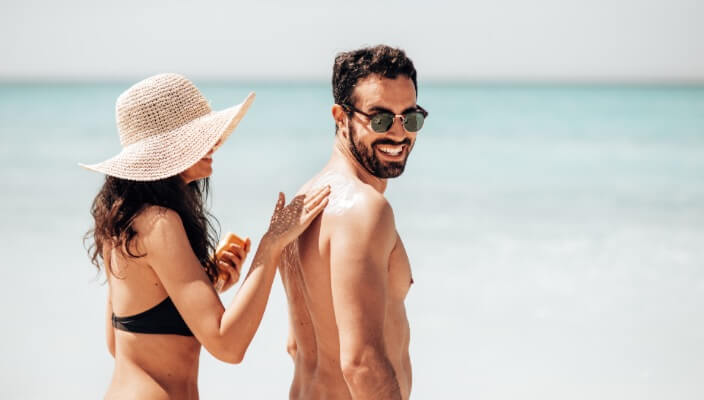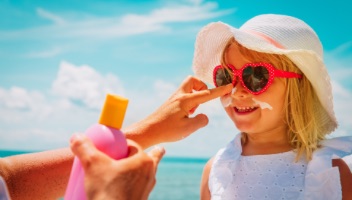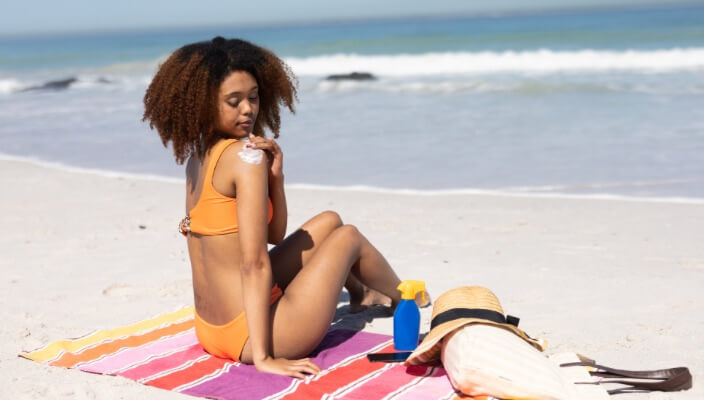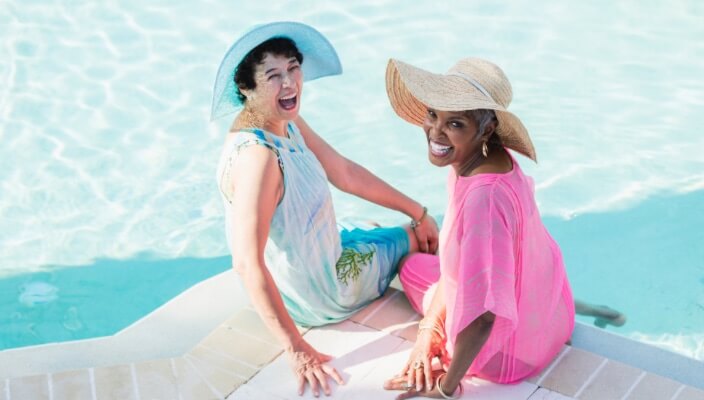Practice Safe Sun Habits Year-Round
Mastering Sun Protection: Unveiling the Secrets to Radiant Skin and UV Defense

The sun makes us happy but can be our skin’s worst enemy. Overexposure to ultraviolet radiation from the sun and tanning beds is the primary cause of skin cancer. Approximately 90% of nonmelanoma skin cancers and 86% of melanoma cancers are associated with exposure to the sun’s UV rays[1]. The good news is that it’s easy to reduce your skin cancer risk by practicing sun safety.
UV Light Causes Skin Cancer
UVA and UVB are the two main types of the sun’s rays, and both contribute to skin cancer by damaging the DNA in your skin:
- UVA (aging rays) cause tanning –– a sign of skin damage –– and premature aging (wrinkles and age spots) and can pass through windows and clouds.
- UVB (burning rays) are the primary cause of sunburn and are blocked by window glass.
Skin cancer risk increases as we age, as UV exposure is cumulative. Skin damage accumulates over the years from prolonged time outdoors and activities like golfing, gardening, yard care, dog walking, commuting to work, etc. Over time, damage to the skin’s DNA triggers mutations that cause cells to multiply rapidly, leading to skin cancer.
Tanning & Sunburn Are Signs of Skin Damage
- A tan is your skin’s way of telling you it is damaged; it darkens as it protects itself from harmful UV radiation.
- Sunburn is a radiation burn that can occur in as little as 11 minutes on unprotected skin; skin turn reds within two to six hours of being burned.
- Just one blistering sunburn in childhood more than doubles the lifetime risk of melanoma[2].
Every time you tan or burn, you damage the DNA in your skin. The more the skin is damaged, the greater your risk of skin cancer and premature aging, which is why it is important to enjoy the sun safely.
Choose an Effective Sunscreen
- Broad-spectrum sunscreens protect against UVA and UVB rays. All sunscreens protect against UVB rays, the cause of sunburns, but UVA rays also contribute to skin cancer and premature aging.
- An SPF of 30 or higher is ideal. The SPF indicates how much UVB light is filtered. We recommend using sunscreen with an SPF of at least 30, which blocks 97% of the sun’s UVB rays. It is important to remember that high-number SPFs last the same amount of time as low-number SPFs and do not allow you to spend additional time outdoors without reapplication.
- Water-resistant formulas stay effective for 40 minutes in the water (labeled as water-resistant) or 80 minutes (very water-resistant), after which you must reapply them. Even if your skin remains dry, you must reapply the product every two hours.
To maximize protection, SPF products can be incorporated into your daily skin regimen, including lip balms, tinted moisturizers and facial powders, and even anti-aging formulas. View our curated collection of professional brand sun protectants at QualDerm's online store.
Use SPF Products Correctly
Proper use of sunscreen is essential. If you experience a sunburn, it usually means you did not follow one or more of the following tips:
- Use sunscreen daily, even on cool and/or cloudy days. Up to 80 percent of UV rays can penetrate clouds[5].
- Apply a sun protectant to dry skin at least 15 minutes before going outside so it absorbs fully.
- Use enough sunscreen to cover ALL skin not covered by clothing, including ears, neck, and the tops of your feet. Most people apply only 25% to 50% of the recommended amount of sunscreen; adults need approximately one ounce (enough to fill a shot glass).
- If your hair is thinning or balding, apply sunscreen to your scalp or wear a hat.
- Protect your lips with a lip balm of SPF 15 or higher.
- Rub SPF products thoroughly, including spray sunscreens, to ensure they absorb fully into the skin.
- Reapply sunscreen approximately every two hours and immediately after swimming or sweating.
- Buy a new sunscreen if your product is past its expiration date or over three years old.
Use Additional Sun-Protectant Measures
No sunscreen filters out 100% of the sun’s rays, so we recommend the following steps to protect your skin:
- Avoid deliberate tanning and tanning beds. Choose self-tanning products instead.
- Limit your time in the sun. Seek shade when UV rays are the strongest (between 10 am and 2 pm). If your shadow is shorter than you, it’s time to get out of the sun.
- Wear sun-protective clothing, including a lightweight long-sleeved shirt, pants, wide-brimmed hat and wraparound UVA/UVB sunglasses. Look for clothing with an ultraviolet protection factor (UPF) label for additional protection.
- Use extra caution near water, snow, sand and cement, as they reflect the sun’s damaging rays, increasing your chance of sunburn.
- Use protective window film in your car and home.
- Get vitamin D through a healthy diet or supplements rather than seeking the sun.
From our QualDerm Family of Brands: Sunscreen Education
Layer your skin’s protection year-round
Sunscreens protect against aging and skin cancer

Get Screened for Skin Cancer at Brassfield Dermatology
Skin cancer is highly treatable when caught early. Visit Brassfield Dermatology for a regular skin exam. It is important to go sooner if you notice anything changing, itching, or bleeding on your skin. Never ignore a new mole or a changing mole, especially if it is larger than a pencil eraser, has irregular borders, bleeds, has an uneven surface, or if you notice more than one color. Schedule your annual Total Body Skin Exam today.
Say yes to sun protection and NO to skin cancer. We can save lives by sharing facts about the dangers of unprotected sun exposure and encouraging one other to check our skin for warning signs.
[1] https://www.skincancer.org/press/2018-skin-cancer-awareness-month/
[2] https://www.skincancer.org/skin-cancer-information/skin-cancer-facts/
[3] https://www.skincancer.org/skin-cancer-information/skin-cancer-facts/
[4] https://www.skincancer.org/skin-cancer-information/skin-cancer-facts/
Related Blog Posts

- Skin Cancer
- Sun Safety
Summer safety is more than just putting on sunscreen; many other factors to consider when keeping yourself and your children safe from damage and potential skin cancer.

- Skin Cancer
- Sun Safety
- Skin Care
If you’re unsure of how to effectively apply sunscreen, we’re here to help. Read our guide on when to apply it, how much sunscreen you should wear, how often to reapply, and more.
Read More
- Skin Cancer
- Sun Safety
Explore important factors for effective sun protection and safeguarding your skin against the harmful effects of UV radiation.
Read More
